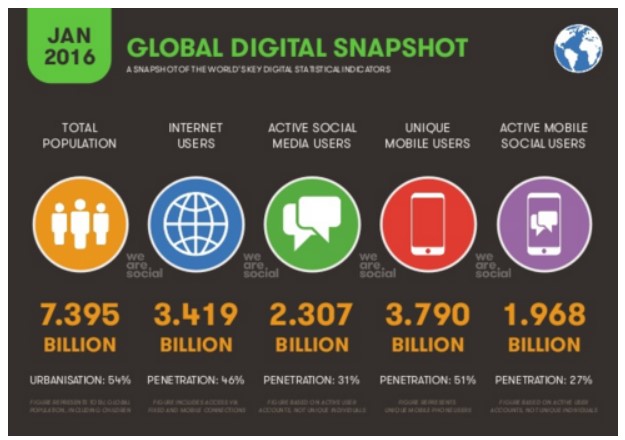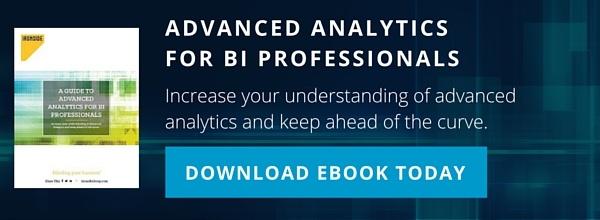Social Media Analytics: Unlocking Your Audience
According to Dave Chaffey’s 2016 global social media research summary, over 2.3 billion people actively use websites like Facebook, Snapchat, Twitter, and LinkedIn to view content or engage with other users . This massive audience represents a huge opportunity for organizations to understand what trends they can connect with, who their ideal customers are, and what the sentiment is around their brand in the marketplace. These insights all become possible through social media analytics.

Image courtesy of smartinsights.com
Social Media Audience Types
Based on their interaction levels, members of the social media audience are categorized as either lurkers, engagers, or influencers. People in each of these categories can have a tremendous impact on how you do business and market your goods and services.
Lurkers
This social media audience reads and accesses a lot of content but don’t engage with it. For example, they don’t click like or add an emoji to express a sentiment on a topic, perhaps because it is not interesting to them or they have nothing to say. The thing is, however, as Ted Rubin states, “Most people are “lurkers” in social media. They are consuming your content but not responding. You are still building a relationship with these people, and they “do” participate… it is just vicariously via those who do engage and interact .” Do not ignore lurkers. They may have discussions about viewed social media content with friends, relatives, and business associates that can influence purchasing decisions. Ninety percent of social media audience members are lurkers.
Engagers
Engagers are active on social media and respond to posts, share info with others, and write comments regarding products or services. These audience members provide usable data for a variety of analyses based on their interests and actions.
Influencers
Influencers are “super engagers.” They comment and blog on popular topics and generate a following based on their perceived expertise. These users can be influential when decisions are being made to purchase products or services. Bloggers can discuss a range of topics, from recipes to politics. An example of a popular food blog, for instance, is Simply Recipes. Tapping into the right influencers, the ones who care about the same topics or products your organization does, will go a very long way toward establishing your brand’s presence on social media.
How Social Media Analytics Helps
Businesses can tap into the right audience for marketing purposes by mining the content on social media websites to find trends, patterns, sentiments, new topics, and impressions based on the writings of engagers and influencers. Understanding the sentiments of lurkers can be a bit challenging due to non-engagement, but you can use creative options to solicit some type of engagement. For example, if they lurk on sporting related content, create an action for participation, such as a survey or poll, and offer a “what’s in it for me” reward like a coupon for completing it.
Analyzing raw data under the lens of social media analytics tools can provide great insight about current and potential consumers in order to make ‘informed decisions’. Keep in mind that once a target audience has been located the analytics tool can only provide metrics or predict what may happen, but cannot guarantee the success of a campaign.
Targeting Your Audience
Reaching or unlocking a social media audience is not all rocket science. Knowing who you want to target and the size of the audience is a good start. For example, if you are looking to reach IT professionals who specialize in database administration, then LinkedIn may be your medium of choice. If you are looking to reach the teen population, then Snapchat, musical.ly, or Vine could be prospects. musical.ly has become one the fastest growing social media platforms for music and lifestyle. It allows users to create and share 15-second videos, most of which are music-related. Topical social media platforms like this are a great option if your offerings directly relate to the content being shared there.
According to Ask, Measure, Learn, a book discussing how social media analytics can help influence customer behavior, you can gain insight about a target audience by:
- Asking the right question,
- Using the right data, and
- Creating the right measure.
The right question should be specific, measurable, actionable, relevant, and time-based (SMART). The right data can be structured or unstructured. An example of structured data is a database table and unstructured can be a tweet or picture. Sampling, specific data selection and keywords, like hashtags, can help turn social information into actionable datasets. Choosing the right metric is very important. It’s okay to measure likes, retweets, mentions, and impressions, but it is equally important to find out how they have added value to your business, brand, or product or service. Social media analytic tools can help businesses find the value in asking the right question, using the right data, and creating the right measure .
Social Media Analytics Tools
There are many social media analytics tools available that are free or for purchase. They include Twitter Analytics, Google Analytics, Tableau Social Media Analytics, and IBM Watson Analytics for Social Media, as well as many others. These tools offer the ability to keep track of likes, tweets, retweets, mentions, sentiments, campaigns, ROI, and much more based on audience participation. IBM Watson Analytics for Social Media, for example, can search keywords located on Twitter, forums, blogs, reviews, videos, and newsfeeds for exploration and predictive modeling. Once data is retrieved, it can power visualizations based on topics, themes, sentiments (negative, positive, neutral, ambivalent), geography, sources, authors, top sites, behavior, and demographics. You can then gain insight into target audience behavior and optimize your strategy through queries and predictions generated from the data.
Below is an example sentiment analysis in Watson Social Media Analytics. It shows sentiment around a popular basketball shoe.

Key Characteristics
A great social media analytics tool should have the ability to:
- Analyze raw data from more than one social media website. For example, tap into consumers who use sites like Facebook, Twitter, Instagram, Vine, musical.ly, LinkedIn, blogs, and newsfeeds.
- Segment your audience based on age, gender, location, profession, negative and positive influencers, and perspective customers
- Measure social media activities such as behaviors, sentiments, affinities, evolving topics, impressions, reach, and ROI. Also measuring these activities for your competitors is equally important.
- Provide data visualization capabilities for easy analysis, such as graphs and dashboards, as they are great at providing a view into your key metrics that is intuitive and actionable.
Conclusion: Building a Social Media Analytics Strategy
Social media has become an important part of our culture. It’s a great platform for marketing to customers and other businesses. Using social media analytics tools can help you unlock your audience and target the most effective methods of communicating with them. If you’re interested in creating a social media strategy for your organization, Ironside can help. Our Analytics Advisory team can help you lay out a roadmap and select the right tools, and our Data Science & Advanced Analytics team can get your chosen solutions implemented and help you build out assets like predictive models that help you proactively influence your social media audience. We look forward to getting you connected.
Want a deeper dive into the text analytics principles behind social media analytics? Check out this tech tip from Ironside Data Scientist Chi Shu describing how it works in SPSS Modeler.






